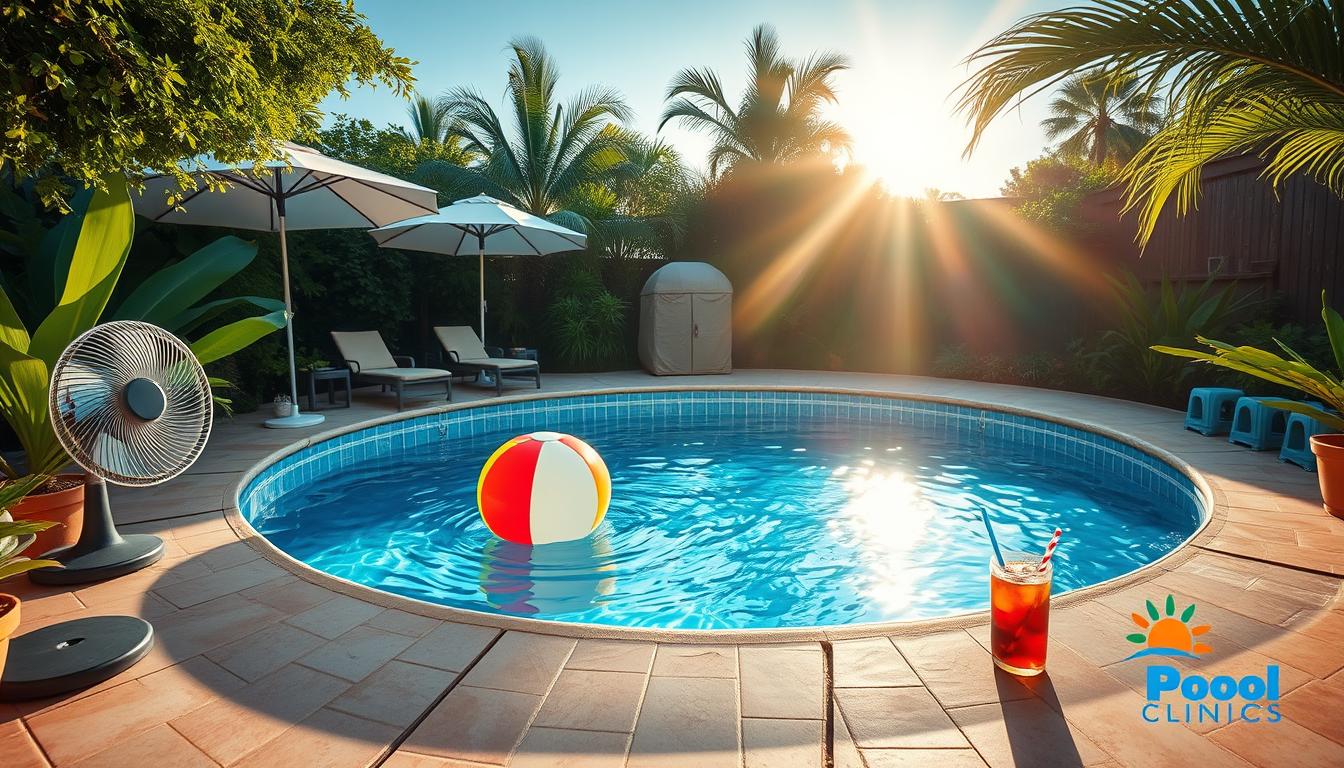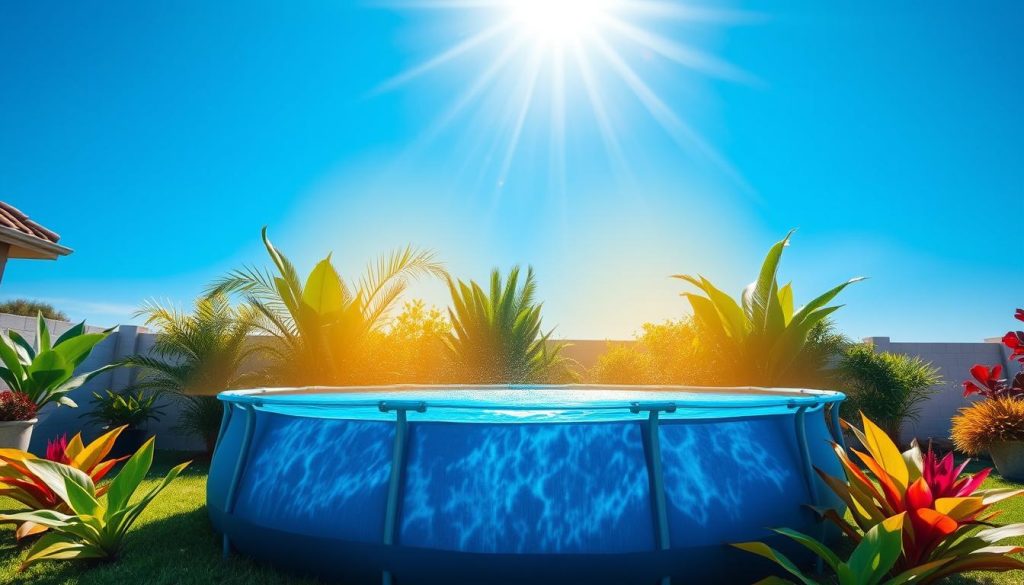
Summer heat can make your above ground pool too warm for comfort. With 20 days annually reaching 100 degrees, maintaining ideal pool temperatures is tough. Most swimmers prefer water between 80-90 degrees.
You don’t need expensive pool chillers or heat pumps. There are simple, cost-effective ways to keep your pool cool and inviting.
Several factors heat up pool water. These include direct sunlight, high temperatures, and heat distribution through circulation systems. Understanding these can help you maintain a comfortable swimming environment.
There are many ways to combat the heat. Use solar pool covers, create shade, add water features, or run your pump at night. These methods can help you enjoy refreshing swims all summer.
Key Takeaways
- Understand the factors that cause pool water to heat up, such as direct sunlight and high ambient temperatures
- Use solar pool covers to reflect sunlight and retain cooler water temperatures overnight
- Create shade over your pool using structures like canopies, pergolas, or shade sails
- Incorporate water features like fountains, waterfalls, or misters to promote evaporative cooling
- Run your pool pump during the cooler hours of the night to circulate and cool the water
- Consider using light-colored or reflective pool paint to minimize heat absorption
- Partially drain and refill your pool with cooler water as a quick, temporary solution
Understanding the Factors Affecting Pool Temperature
Pool owners often struggle with rising water temperatures in summer. Understanding key factors helps develop strategies for a comfortable swimming environment. Let’s explore what impacts pool temperature and how to keep it cool.
Direct Sunlight and High Ambient Temperatures
Direct sunlight is a major cause of warm pool water. Extended sun exposure leads to solar heat absorption and temperature increase. High air temperatures also warm the water surface, contributing to overall temperature rise.

Pool Circulation Systems Distributing Heat
Circulation systems influence pool temperature by distributing heat evenly. As pumps and filters clean the water, they prevent cooler pockets from forming. This process maintains consistent temperatures but can make cooling challenging during hot weather.
Surface Area Exposed to Sunlight
The pool’s surface area affects water temperature. Larger pools with more exposed surface absorb more solar heat. This increased exposure allows more solar energy to penetrate, leading to faster heating.
| Pool Type | Recommended Temperature Range |
|---|---|
| Competitive swimming pools | 24°C – 27°C |
| Public swimming pools | 26°C – 28°C |
| Private swimming pools | 26°C – 30°C |
| Therapy pools | 30°C – 36°C |
| Spas | 36°C – 40°C |
Understanding these factors helps assess your pool’s unique characteristics. This knowledge allows you to implement targeted solutions for keeping water cool. You can now explore effective strategies to combat rising temperatures and enjoy refreshing swims.
Effective Strategies to Keep Your Above Ground Pool Cool
Hot summer days can make your above ground pool water uncomfortably warm. Let’s explore some effective ways to keep your pool cool and refreshing.
Using Reflective or Light-Colored Pool Covers
Reflective pool covers are a cost-effective way to reduce heat absorption. They reflect the sun’s rays, minimizing heat entering the water. Light-colored covers also help by absorbing less heat than darker ones.
Installing Shade Structures, Canopies, or Pergolas
Shade structures like canopies or pergolas limit direct sunlight on the water. This helps maintain a lower water temperature. It also creates a comfortable lounging area around the pool.
Incorporating Water Features like Fountains, Waterfalls, or Misters
Pool water features promote evaporation, resulting in heat loss. They distribute cooler water throughout the pool. These features also create a relaxing atmosphere around your pool area.
Investing in Pool Chillers or Heat Pumps
Pool chillers actively cool the water, lowering temperature by several degrees. Heat pumps can both cool and heat pool water. These options offer precise temperature control for optimal swimming comfort.
| Cooling Method | Effectiveness | Cost |
|---|---|---|
| Reflective Pool Covers | Moderate | Low |
| Shade Structures | Moderate to High | Moderate |
| Water Features | Low to Moderate | Moderate |
| Pool Chillers | High | High |
| Heat Pumps | High | High |
Running the Pool Pump at Night
Nighttime pool circulation helps maintain cooler water temperatures. Running your pool pump during cooler hours dissipates heat from the water. This method works well with other cooling strategies like daytime reflective covers.
Using Light-Colored or Reflective Pool Paint
The color of your pool’s interior impacts its temperature. Light-colored or reflective pool paint reduces heat absorption. Lighter colors reflect more sun rays, keeping water cooler than darker colors.
Partially Draining and Refilling with Cooler Water
In extreme cases, partially replace warm water with fresh, cooler water. This provides immediate relief from the heat. Consider environmental impact and local water conservation measures before using this method.
Combining these strategies can maintain comfortable water temperature in your above ground pool. You have many options to keep your pool inviting and refreshing all summer long.
Conclusion
There are many cool pool strategies to beat the summer heat. These include pool covers, shade structures, water features, and pool chillers. Understanding factors like sunlight and circulation systems helps make smart choices for pool cooling.
Small changes can make a big difference in pool comfort. Try running the pump at night or using light-colored pool paint. Partially draining and refilling with cooler water also helps maintain a pleasant swimming environment.
Don’t let hot weather stop you from enjoying your backyard oasis. Try different cooling techniques to create a refreshing retreat. With some effort, you can make every swim delightful, even on the hottest days.







